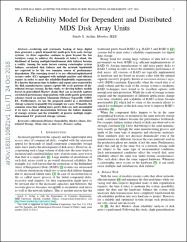Please use this identifier to cite or link to this item:
https://hdl.handle.net/20.500.11779/487Full metadata record
| DC Field | Value | Language |
|---|---|---|
| dc.contributor.author | Arslan, Şuayb Şefik | - |
| dc.date.accessioned | 2019-02-23T10:37:03Z | |
| dc.date.available | 2019-02-23T10:37:03Z | |
| dc.date.issued | 2018 | - |
| dc.identifier.citation | Arslan, S. S. (November 29, 2018). A Reliability Model for Dependent and Distributed MDS Disk Array Units. Ieee Transactions on Reliability, 1-16. | en_US |
| dc.identifier.issn | 0018-9529 | - |
| dc.identifier.uri | https://hdl.handle.net/20.500.11779/487 | - |
| dc.identifier.uri | http://dx.doi.org/10.1109/TR.2018.2878503 | - |
| dc.description.abstract | Archiving and systematic backup of large digital data generates a quick demand for multi-petabyte scale storage systems. As drive capacities continue to grow beyond the few terabytes range to address the demands of today’s cloud, the likelihood of having multiple/simultaneous disk failures became a reality. Among the main factors causing catastrophic system failures, correlated disk failures and the network bandwidth are reported to be the two common source of performance degradation. The emerging trend is to use efficient/sophisticated erasure codes (EC) equipped with multiple parities and efficient repairs in order to meet the reliability/bandwidth requirements. It is known that mean time to failure and repair rates reported by the disk manufacturers cannot capture life-cycle patterns of distributed storage systems. In this study, we develop failure models based on generalized Markov chains that can accurately capture correlated performance degradations with multiparity protection schemes based on modern maximum distance separable EC. Furthermore, we use the proposed model in a distributed storage scenario to quantify two example use cases: Primarily, the common sense that adding more parity disks are only meaningful if we have a decent decorrelation between the failure domains of storage systems and the reliability of generic multiple single-dimensional EC protected storage systems. | en_US |
| dc.language.iso | en | en_US |
| dc.publisher | IEEE Transactions on Reliability | en_US |
| dc.relation.ispartof | Transactions on Reliability | en_US |
| dc.rights | info:eu-repo/semantics/closedAccess | en_US |
| dc.rights.uri | http://creativecommons.org/licenses/by-nc-nd/3.0/us/ | * |
| dc.subject | Distributed storage | en_US |
| dc.subject | Markov chains | en_US |
| dc.subject | Maximum distance separability (mds) | en_US |
| dc.subject | Mean time to data loss (mttdl) | en_US |
| dc.subject | Erasure coding | en_US |
| dc.title | A Reliability Model for Dependent and Distributed Mds Disk Array Units | en_US |
| dc.type | Article | en_US |
| dc.identifier.doi | 10.1109/TR.2018.2878503 | - |
| dc.identifier.scopus | 2-s2.0-85057820235 | - |
| dc.authorid | Şuayb Şefik Arslan / 0000-0003-3779-0731 | - |
| dc.authorid | Şuayb Şefik Arslan / K-2883-2015 | - |
| dc.description.woscitationindex | Science Citation Index Expanded | en_US |
| dc.identifier.wosquality | Q1 | - |
| dc.description.WoSDocumentType | Article | - |
| dc.description.WoSInternationalCollaboration | Uluslararası işbirliği ile yapılmayan - HAYIR | en_US |
| dc.description.WoSPublishedMonth | Mart | en_US |
| dc.description.WoSIndexDate | 2019 | en_US |
| dc.description.WoSYOKperiod | YÖK - 2018-19 | en_US |
| dc.identifier.scopusquality | Q1 | - |
| dc.relation.publicationcategory | Makale - Uluslararası Hakemli Dergi - Kurum Öğretim Elemanı | en_US |
| dc.identifier.endpage | 16 | en_US |
| dc.identifier.startpage | 1 | en_US |
| dc.department | Mühendislik Fakültesi, Bilgisayar Mühendisliği Bölümü | en_US |
| dc.identifier.wos | WOS:000460728600008 | - |
| dc.institutionauthor | Arslan, Şuayb Şefik | - |
| item.grantfulltext | open | - |
| item.languageiso639-1 | en | - |
| item.openairetype | Article | - |
| item.cerifentitytype | Publications | - |
| item.fulltext | With Fulltext | - |
| item.openairecristype | http://purl.org/coar/resource_type/c_18cf | - |
| crisitem.author.dept | 02.02. Department of Computer Engineering | - |
| Appears in Collections: | Bilgisayar Mühendisliği Bölümü Koleksiyonu Scopus İndeksli Yayınlar Koleksiyonu / Scopus Indexed Publications Collection WoS İndeksli Yayınlar Koleksiyonu / WoS Indexed Publications Collection | |
Files in This Item:
| File | Description | Size | Format | |
|---|---|---|---|---|
| 1810.10621.pdf | Yayıncı Sürümü - Makale | 396.29 kB | Adobe PDF |  View/Open |
CORE Recommender
Sorry the service is unavailable at the moment. Please try again later.
This item is licensed under a Creative Commons License
